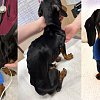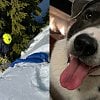Dogs evolved muscles around their eyes to make them look cuter so humans would want to care for them, a new study suggests.
The research – by scientists in the U.K. and U.S. – was based around comparing the anatomy and behaviour of dogs and their closest relatives, wolves.
Their facial muscles were similar in all areas except for above the eyes.
Dogs have a small muscle allowing them to “intensely” raise their inner eyebrow, the study found, while wolves do not.

“The findings suggest that expressive eyebrows in dogs may be a result of humans’ unconscious preferences that influenced selection during domestication,” Dr. Juliane Kaminski, from the University of Portsmouth, explained.
“When dogs make the movement, it seems to elicit a strong desire in humans to look after them. This would give dogs that move their eyebrows more of a selection advantage over others and reinforce the ‘puppy dog eyes’ trait for future generations.”
Dogs and wolves also use their eyebrows differently in the presence of humans, the researchers found.
When a human looks at a dog for two minutes, it raises its eyebrows to higher intensities than a wolf does.
Dr. Kaminski added: “The AU101 movement is significant in the human-dog bond because it might elicit a caring response from humans but also might create the illusion of human-like communication.”
Professor Anne Burrows, from Duquesne University, said it suggests a remarkably hasty evolution.

“This is a striking difference for species separated only 33,000 years ago and we think that the remarkably fast facial muscular changes can be directly linked to dogs’ enhanced social interaction with humans,” she said.
Professor Bridget Walder of the University of Portsmouth, meanwhile, said the effect on dogs was to give them a “childlike appearance”.
“It could also mimic the facial movement humans make when they’re sad," she added. "Our findings show how important faces can be in capturing our attention, and how powerful facial expression can be in social interaction."
One species of dog, however, has insisted on keeping its dignity.
The Siberian husky was the only pooch studied by researchers to not have the eye muscle.
















